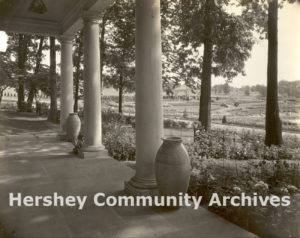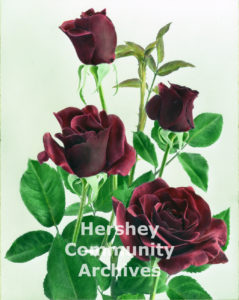Hershey Gardens
!["Pergola and Pool, Hershey Rose Garden, Hershey, Pa." 1938 (Curt Teich and Company, Chicago, Illinois [8AH1648])](https://hersheyarchives.org/wp-content/uploads/2019/07/PC217-300x186.jpg)
In 1935 J. Horace McFarland, a resident of Harrisburg, a nationally known leader in the city beautiful movement and active in the American Rose Society contacted Alexander Stoddart, Hershey’ publicist, to invite him to visit McFarland’s Breeze Hill Gardens in Harrisburg. McFarland also included Milton Hershey in his invitation. Breeze Hill was acclaimed for its roses. While the visit did not immediately take place, in July 1935 McFarland wrote to Stoddart that,
I have a desire to get Mr. Hershey to see the advantage of a rose garden. He does things in such a magnificent way and so clearly operates for human welfare that I believe he would be impressed with the possibilities afforded only by the rose for advancing human welfare.
I could see a great rose garden in Hershey which would increase the attractions of that marvelous place, but there is a peculiar opportunity open right now, not yet offered to any man of means, to do something at Washington which would give international renown.
No further correspondence took place until the next year. In a letter to Milton Hershey dated April 14, 1936, McFarland wrote advocating that Mr. Hershey should consider “the establishment . . of a public rose-garden.” McFarland also renewed his request that Mr. Hershey support the establishment of a “National Rosarium close to Washington.” He requested that the two men meet for further discussion of these proposals.
Milton Hershey immediately replied to McFarland’s letter and indicated his interest in the idea of a rose garden. The two men made plans to meet when the Pennsylvania State Federation of Garden Clubs would meet in Hershey later in April. Their first meeting took place Wednesday afternoon, April 29, 1936. What transpired during that meeting was remarkable.
Harry Erdman, responsible for all things horticultural in Hershey, related what happened next in a 1955 oral history interview. According to Erdman, Milton Hershey had been considering expanding a small rose garden at his home, High Point, for some time. Erdman had personally identified a piece of land just south of the Hotel Hershey as a place that would be ideally suited for some sort of garden. Horace McFarland’s enthusiasm for a rose garden in Hershey, coincided nicely with a similar idea that was already being considered.
After McFarland and Milton Hershey’s initial meeting, Mr. Hershey attended the Garden Federation dinner meeting that same evening as a guest of McFarland who was the keynote speaker. McFarland took the opportunity to publicly ask Milton Hershey for financial support of a National Rose Garden in Washington, D.C. According to Erdman, Milton Hershey’s reply was:
Well, we have been planning a Garden of our own; and, before we give that amount of money for the politicians to play with, we better spend some of it at our own place and see what interest people take in it.
Erdman learned this story the next day when Milton Hershey called him to a meeting at his apartment in High Point. Mr. Hershey directed Erdman to stake out the new garden and he would come look at the site when Erdman was ready. Several days later Erdman brought Milton Hershey to the site and Hershey immediately agreed that the rose garden project could move ahead. In June 1936 plans were drawn up and during the summer the plot was graded and a small manmade pond was formed out of an erosion gully. The first plants were put in November 1936.
Most of the roses came from Conard-Pyle Company’s Star rose collection. Over 12,000 rose bushes in 450 varieties were planted. The Gardens opened to the public in June 1937, with more than 5,000 visitors during the first week of it opening. The Rose Garden had over 200,0000 visitors during its first season.
The success of the Rose Garden resulted in sections being added The Rose Garden continued to grow with new sections of roses added in 1937, 1939 and 1941.
The American Rose Society honored Milton Hershey’s support of roses at its annual meeting held in September 1938 at the Hotel Hershey. At the closing luncheon, a poem dedicated to naming a rose after Mr. Hershey was read and L.B. Coddington, a prominent rose hybridiser from Murry Hill, NJ, proposed that a scarlet-crimson red (velvet black red) rose he was developing be named ‘M.S. Hershey.’ The rose was formally introduced on September 13, 1940 and was available for retail sale for the 1941 season.
In early 1941 Milton Hershey was considering how to develop the land east of the Rose Garden. After 20 minutes of heated onsite consultation between Harry Erdman, engineers, real estate developers and farmers, the land was deemed inappropriate for farming or a housing development. Mr. Hershey then turned to Harry Erdman and said, “All right, Erdman, go ahead, make a garden out of it. We’ll make an awful lot of other people happy.” When Erdman asked if Mr. Hershey wanted to see a plan or cost estimates Mr. Hershey replied, “No, go ahead. If it gets too big, I’ll stop you. Make it look as good as the Rose Garden does, and everything will be all right.” Over the next few years, Harry Erdman supervised the planting of 58,000 trees, shrubs, evergreens, perennials and annuals. Beds of spring bulbs, including 30 varieties of daffodils and 45 varieties of tulips, were introduced in 1942.
Beginning in 1953, Hershey Garden’s annual spring bulb bloom was showcased with a Tulip Festival. For many years the Gardens also incorporated tulip beds in the shape of windmills, wooden shoes and other Dutch motifs. Similar to the Gardens approach to roses, the newest varieties of tulips were included in the flowering display.
In 1954, High Point’s original 1918 Rose Garden was moved to the Hershey Rose Garden. The roses were transplanted in the same form or pattern as the original garden.
By 1955 the Gardens had 42,000 roses and 1200 varieties. That year John Meszaros became the new Director of Horticulture replacing Harry Erdman who was retiring. Under Meszaros’s guidance the Gardens plantings of annuals and tulips expanded. Chrysanthemum displays were incorporated in the fall to stretch color displays into three seasons. There was a great focus on planting several varieties of each type of flower. The Gardens formed relationships with different floral societies leading to donations of new perennials.
During the 1960s important collections of Japanese maples, peonies and hollies were established. In 1967 the Gardens also received an important collection of 400 varieties of evergreen plants, including almost 25 varieties of hemlock, from Henry Hohman, a noted collector and propagator of dwarf and unusual conifers. In recognition of the growth and expansion of the Gardens collections its name was changed to Hershey Rose Garden and Arboretum in 1966.
In 1975, a new Director, William Bowman, brought more significant developments to the Gardens’ plans. The number of varieties of annuals and roses were reduced to focus on the more important varieties. Six themed gardens were planned and built to generate a wider public interest. Fountain Garden, English Formal Garden, Colonial Garden, Rock Garden, Japanese Garden and Italian Garden all opened in June 1979. The new additions to the Gardens and the focus on a broader scope of audience brought about a final name change to Hershey Gardens.
In 1985, Mark Gruin took over leadership of the Gardens. With the impressive landscape additions made by his predecessors, Gruin focused on promoting the Gardens. In September 1986 he held the first annual Hershey Arts Festival of Fine Art. The show was held at the Gardens for five years. Gruin also pursued establishing the Hershey Gardens as not only a display garden but also as an All-American Garden for the American Rose Selections organization. For this designation a garden must fulfill three functions. In addition to being a display garden for soon to be released new commercial roses, an All-American Garden also serves as a two year trial test gardens for both miniature and standard roses. There are only approximately 30 test garden sites, of which only two are public gardens in the United States.
Hershey Gardens was originally owned by Hershey Estates, now known as Hershey Entertainment and Resorts Company. In 1989, ownership of the Gardens was transferred to The M. S. Hershey Foundation, a non-profit education and cultural organization serving the community and its visitors.
In celebration of its 60th anniversary in 1997, Hershey Gardens launched a three-phase program of renovations designed to preserve its original features and to expand its audience. Although the original 1936 rose garden design remained in tact, many beds had been removed over the years. As part of Phase I, beds were reinstalled and 7,000 plants added.
A new addition to the Gardens began in 1997 when a wing of the original Hershey Estates Greenhouse structure, built in 1930, was donated to the Gardens by a local resident who had purchased it in the 1960s when the greenhouse was torn down. Since it was no longer useful as a greenhouse, a proposal was made to transform it into a butterfly house. The Butterfly House opened to the public on June 20, 1998. The outdoor seasonal butterfly house houses over 400 butterflies representing 25 species. The original greenhouse structure was replaced with a new steel and mesh structure in 2010.
The Children’s Garden opened June 2003. Described as a “garden to sweeten the imagination, The Children’s Garden covers 1 1/2 acres and features over 20 themed gardens offering opportunities for hands-on learning and self-discovery.


